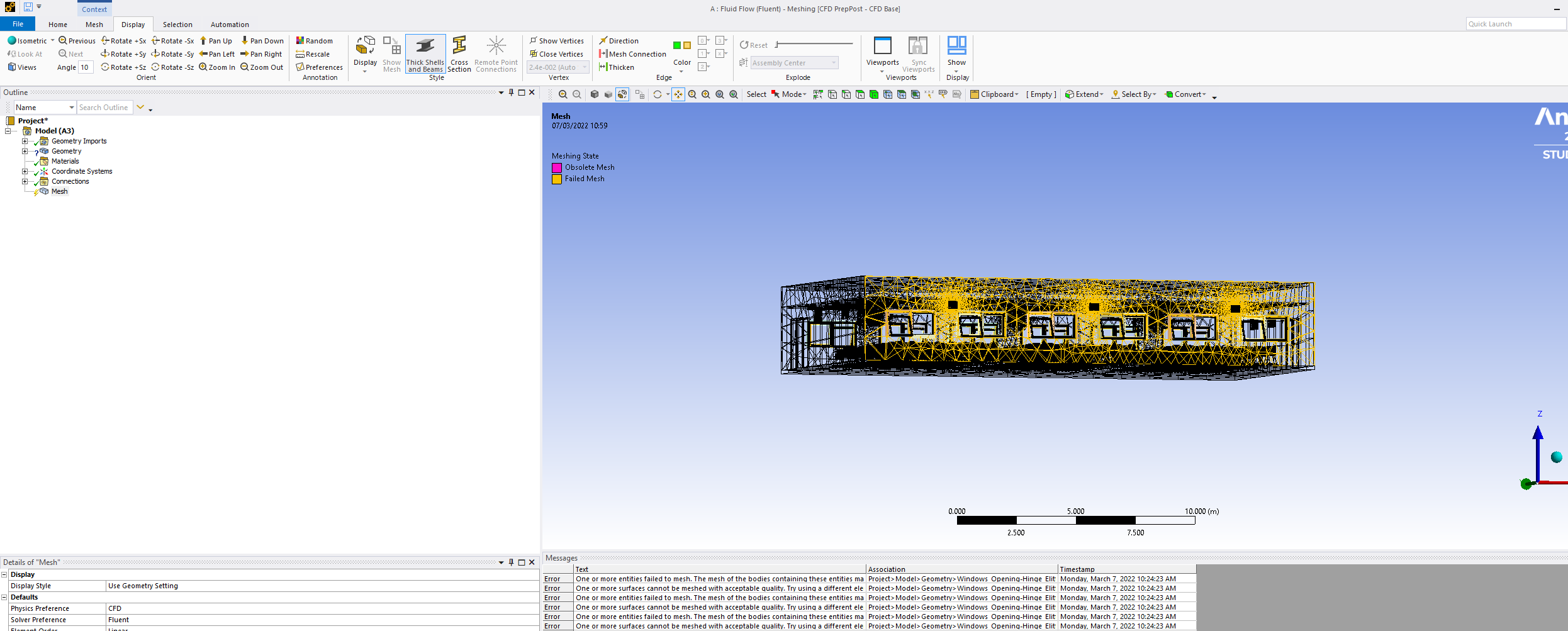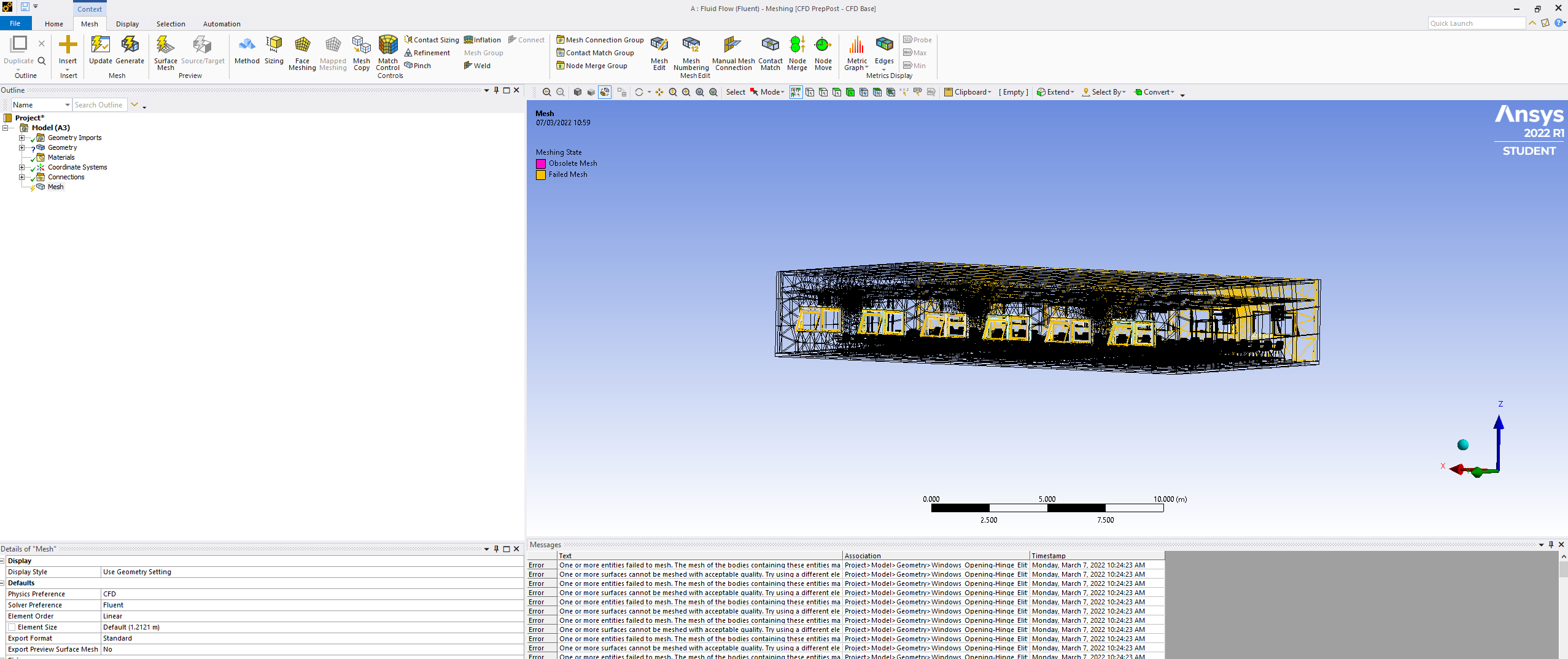-
-
December 3, 2021 at 12:29 pm
MerlinWilliams
SubscriberHi, I am new to ansys and am trying to create meshes of a model for the fluid and solid domains for an FSI simulation of blood flow in an aneurysm.
I started with an stl file of the geometry and imported it to spaceclaim converting it to a solid body. From here I made an outward shell to create the 'solid' domain for my problem (ie the aneurysm wall). I then trimmed the inlets and outlets of the domains to remove the new facets that had been added with in the shelling step. The output can be seen in the image below. I then converted the shelled part, seen in grey below, to a solid body.
December 3, 2021 at 2:38 pmpeteroznewman
SubscriberYou will need to spend some time cleaning up your geometry before meshing. You can easily get rid of the sliver faces on the cut end face by simply using a plane to remove a thin slice of the solids.
Here is the Google Search Results with links to this topic on this site.
I have some videos on my YouTube channel on this topic.
December 3, 2021 at 2:44 pmMerlinWilliams
SubscriberAh that looks very helpful thank you very much. I will give them a look and let you know how I get on
December 6, 2021 at 12:28 pmMerlinWilliams
SubscriberI have had a chance to watch your videos and I think it has helped a bit. Firstly when I tried to use the AutoSkin tool on the stl file it did not work and there were some errors that popped up which didn't allow me to do the auto skin. Shown in the images below:
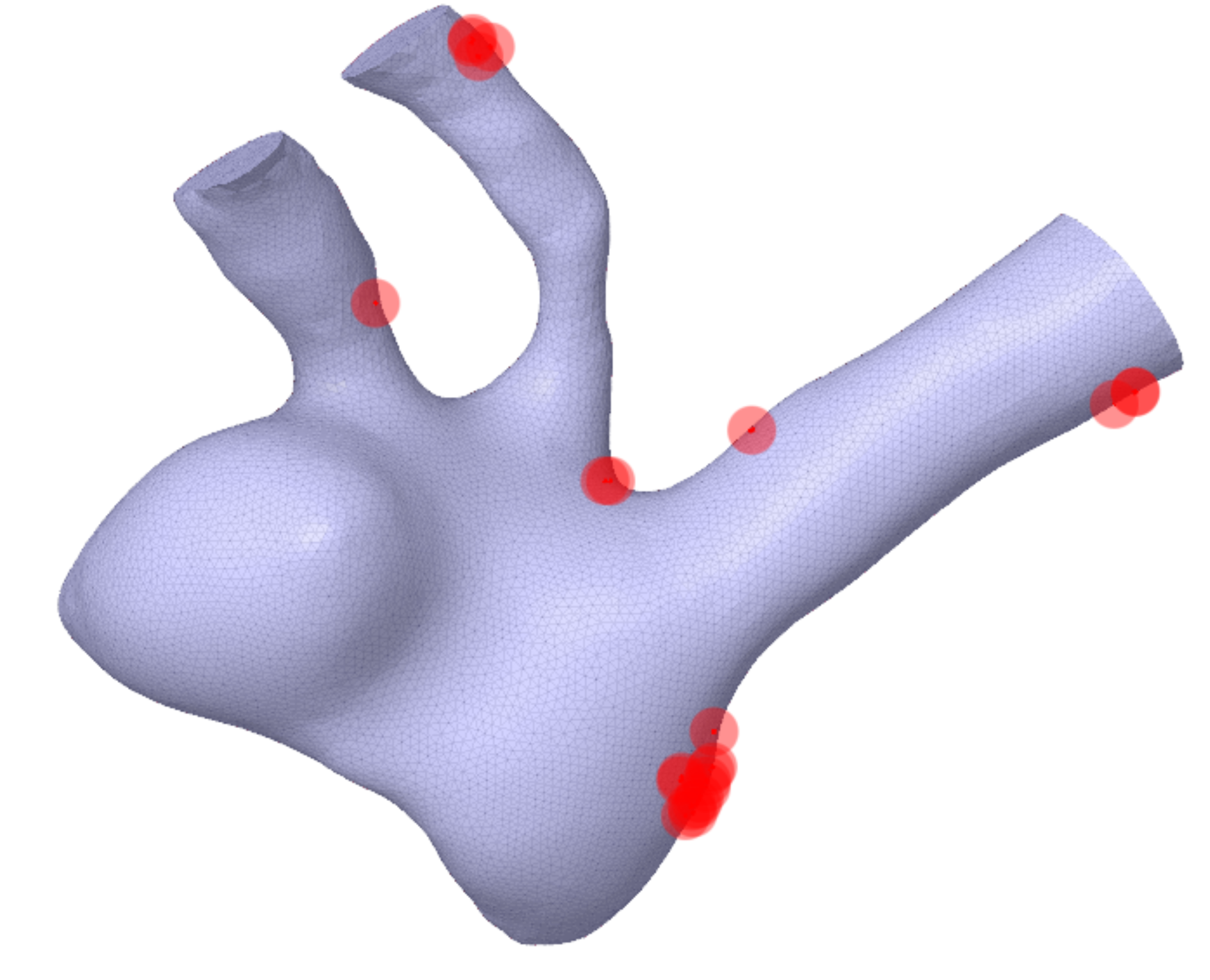
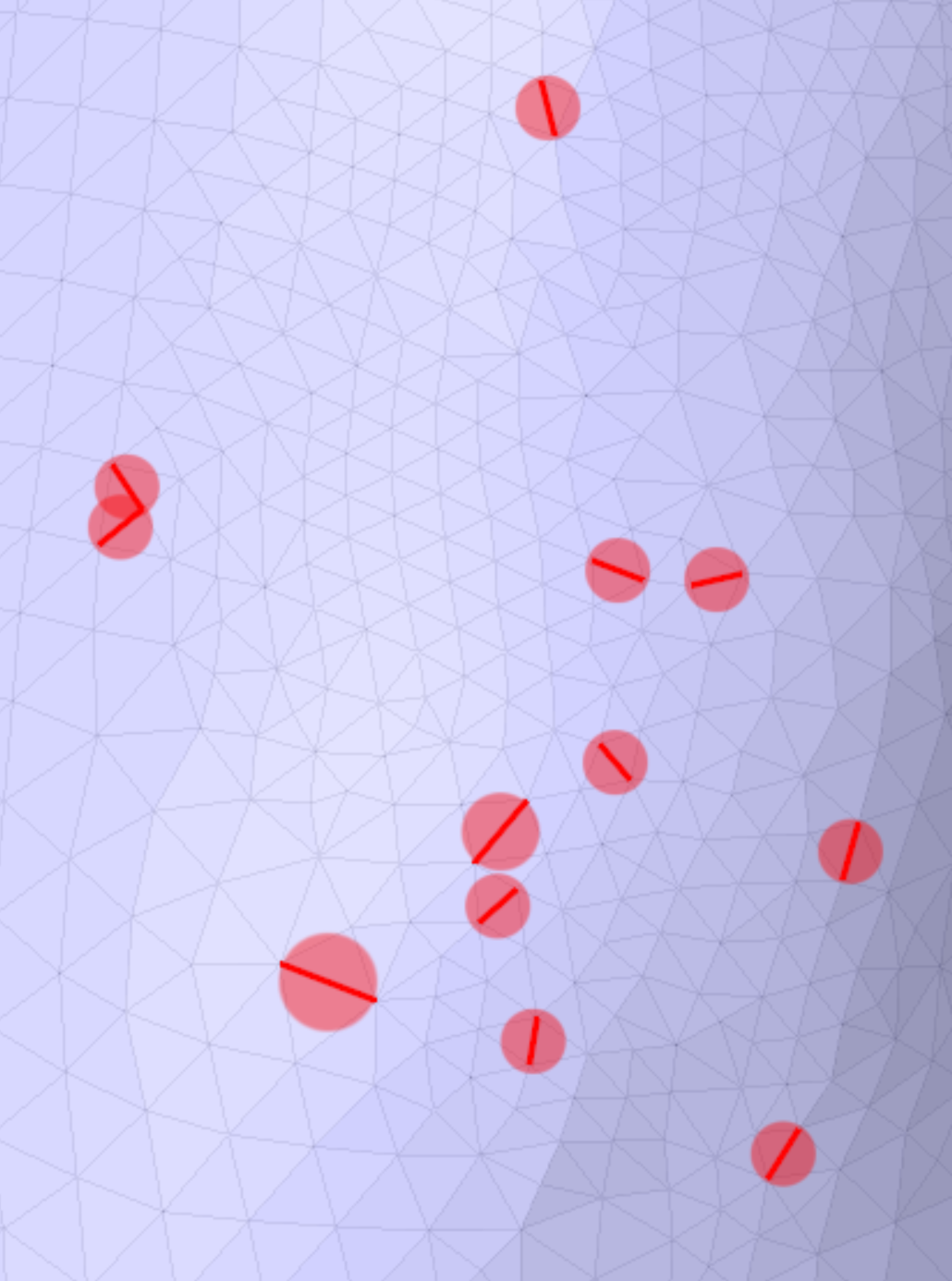
So I then tried the process outlined in the third video you posted. I imported an stl file as a solid body into spaceclaim to have the same starting point as you of a solid body. I successfully completed the process and ended up with the thickened surface and a volume with the result shown below:
 I then have now imported it into Ansys mesher to try create a mesh for both domains. However when I imported it I got the warning message 'A body was processed that faces but no facets. Mesh generation and mass property calculations may be impacted'. I could successfully produce a mesh for the fluid interior of the model, but when I tried to mesh the solid exterior of the model it failed (shown below) and gave me the error message 'A mesh could not be generated using the current meshing options and settings'. There were none of the sliver elements at the inlet and outlets as before and I am not sure what is wrong.
I then have now imported it into Ansys mesher to try create a mesh for both domains. However when I imported it I got the warning message 'A body was processed that faces but no facets. Mesh generation and mass property calculations may be impacted'. I could successfully produce a mesh for the fluid interior of the model, but when I tried to mesh the solid exterior of the model it failed (shown below) and gave me the error message 'A mesh could not be generated using the current meshing options and settings'. There were none of the sliver elements at the inlet and outlets as before and I am not sure what is wrong.

Could you please help me as to the next steps that I should take to successfully create the two separate meshes?
Also at the end of your third video you posted you mention that there are tools to smooth a body like the one you were using, do you have a video of that process? Because my current starting point is using a model that I have smoothed and refined in Meshmixer so I wonder if that is causing some problems and it might be simpler to do the refining in Ansys as well from the initial coarse stl file.
Thank you very much for your time.
December 6, 2021 at 12:58 pmpeteroznewman
SubscriberIn SpaceClaim, did you use the Separate All button on the Facets ribbon? That will let you hide the main body and delete all the tiny bodies. Did you use the Check button?
December 6, 2021 at 1:00 pmMerlinWilliams
SubscriberNo I did not use that, at which stage of the process should I use that?
December 6, 2021 at 1:01 pmpeteroznewman
SubscriberDo that at the start when you first import the STL before you do anything else.
December 6, 2021 at 1:03 pmMerlinWilliams
SubscriberThank you I will try that again.
Is this in relation to trying the autoskin method or the method in your third video? Because for the other method in your third video I imported the model as a solid body not an stl file
December 6, 2021 at 1:10 pmDecember 6, 2021 at 3:19 pmpeteroznewman
SubscriberAnd the Auto Fix button does not repair that? What is the icon in the Structure tree, a closed facet body or open surface facets?
Create a plane slightly inside the body and use the Split button to slice a thin section off the end. Delete that end. That should give you a clean facet body.
December 6, 2021 at 3:46 pmMerlinWilliams
SubscriberIt is a closed facet body and the auto fix button does nothing. I cut off the thin sections off the end and tried auto skin again but the same problem appeared. as seen below
 Could there be another way around the problem? The method in your third video seems exactly what I need as I need a fluid domain inside of a solid domain, or do you think the problems meshing with that method and the problem with auto skin are linked? What are the ways to smooth an stl file or solid model that you mention at the end of your third video?
Could there be another way around the problem? The method in your third video seems exactly what I need as I need a fluid domain inside of a solid domain, or do you think the problems meshing with that method and the problem with auto skin are linked? What are the ways to smooth an stl file or solid model that you mention at the end of your third video?
I am very grateful for your time and help.
December 6, 2021 at 5:32 pmpeteroznewman
SubscriberUsing Thicken is only helpful if you can assume a constant wall thickness. Arteries typically have varying wall thickness, so CT imaging delivers both the inner and the outer surface of the artery wall.
If you put the cleaned up version of your STL file into a .7z or .rar archive, you can attach it to your reply and I will take a look.
December 7, 2021 at 10:50 amMerlinWilliams
Subscriberfor my research assuming a constant wall thickness is acceptable and the geometry I have been given is just the outer surface. Also for the purpose of the research it is acceptable to thicken the model outwards or inwards to create the artery wall.
That is very kind of you to have a look, I really appreciate it.
Merlin
December 7, 2021 at 12:43 pmpeteroznewman
SubscriberWhat version of ANSYS are you using?
Is the STL file in mm?
December 7, 2021 at 2:01 pmMerlinWilliams
SubscriberYes the stl file is in mm, im using Ansys 2021 R2 Student
December 7, 2021 at 6:51 pmpeteroznewman
SubscriberI have made some progress, but don't have the final geometry you want.
What is the wall thickness you want?
December 7, 2021 at 8:51 pmDecember 8, 2021 at 9:56 amMerlinWilliams
SubscriberOh wow that looks amazing thank you very much! The wall thickness that I preferably want is 0.3679mm if it is thickening it outwards.
How should I now progress to get to something like the patch solid model that you linked, but with the correct wall thickness? I can't thicken it as its not faceted, so would I use shell and shell outwards and then use volume extract to create the fluid domain? However, I am not sure how I might use the thickened facets file you linked.
December 8, 2021 at 4:56 pmMerlinWilliams
SubscriberI am very grateful for you helping me but, the model 'patch solid' has increased in size, did you specify the units as mm when opening it? The diameter of the largest opening should be about 3mm, how would I go about making it back to its original size?
December 8, 2021 at 11:30 pmpeteroznewman
SubscriberSTL files have no units associated with them. When you open an STL file in SpaceClaim, it defaults to Automatic. I have no idea what that means.
It is vital to know the units the STL file was created with. In your case, it is mm. Unfortunately, I didn't get that information before I started playing with the file.
If you know the size of a feature in the model, you can use the Scale tool in SpaceClaim to resize the geometry to the correct size.
Now that you have provided a specific wall thickness and direction, I can use that in a fresh attempt.
December 9, 2021 at 3:21 ampeteroznewman
SubscriberDecember 9, 2021 at 2:50 pmMerlinWilliams
SubscriberThank you so much for your time and help, I am incredibly grateful.
One final question. Upon creating the fluid domain by using the volume extract tool and then importing it to the meshing software in Ansys I will need to create a mesh where the faces and nodes of the outer surface of the fluid domain mesh and the inner surface of the solid domain mesh match up. Do you have any idea how I would do this? Would the match control work, or would I have to create shared topology between the fluid and solid domain?
Thank you very much again for your continued help
Merlin
December 9, 2021 at 6:09 pmpeteroznewman
SubscriberAfter you do the volume extract in SpaceClaim, use the Share button on the Workbench tab. That will ensure the nodes at the interface are shared between the fluid and the solid.
December 9, 2021 at 6:18 pmMerlinWilliams
Subscriber,ok thank you.
And will this ensure that the nodes at the interface are shared even if I add in a feature like an inflation layer for the fluid domain?
December 9, 2021 at 6:19 pmpeteroznewman
SubscriberYes.
December 9, 2021 at 6:20 pmMerlinWilliams
SubscriberAmazing thank you very much.
December 10, 2021 at 11:16 amMerlinWilliams
SubscriberI am now trying to create the mesh for the solid domain and I want to make the solid domain two elements thick. How can I do this? I have seen the thread linked below but I am still not sure.
Is it also possible to specify the two element thickness for only the solid domain and not the fluid domain and make sure that the elements and nodes still match for the inner face of the solid domain and outer face of the fluid domain?
December 12, 2021 at 4:11 ampeteroznewman
SubscriberHere is an artery mesh with 4 elements through the thickness.
 Here is the fluid mesh with inflation layers.
Here is the fluid mesh with inflation layers.
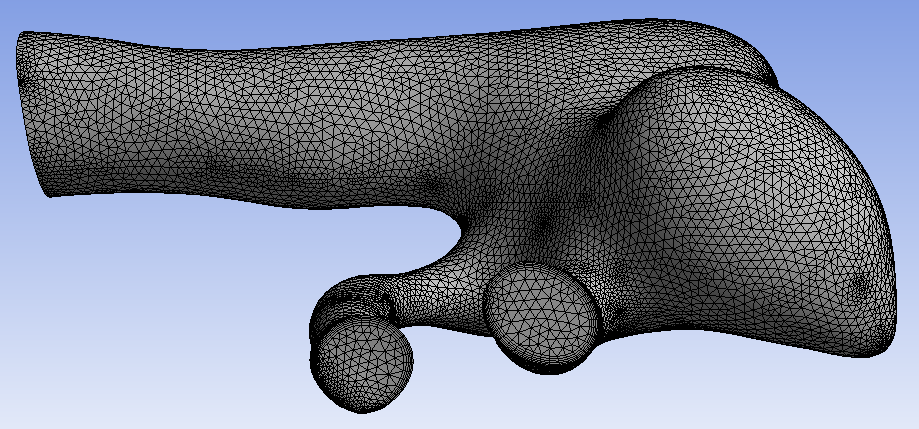 There is a different mesh on the artery than the fluid, but an identical mesh is not required for one-way FSI where the fluid flow is solved first and the pressure used as a load on the artery
There is a different mesh on the artery than the fluid, but an identical mesh is not required for one-way FSI where the fluid flow is solved first and the pressure used as a load on the artery
 Tell me more about how you want to do your FSI. The Student license only permits one-way FSI.
Tell me more about how you want to do your FSI. The Student license only permits one-way FSI.
December 13, 2021 at 10:19 amMerlinWilliams
SubscriberSo I am actually doing the FSI simulation on OpenFOAM not Ansys and am just going to export the mesh from Ansys to OpenFOAM.
The fsi I need to implement is a 2 way fully coupled partitioned approach. Will this mean that I have to use the same type of mesh for each domain?
December 13, 2021 at 12:40 pmpeteroznewman
SubscriberI don't know OpenFOAM, you will have to ask on their support forum. Maybe they have a contact definition, I don't know, but you can't go wrong with a congruent mesh that shares nodes at the interface.
December 13, 2021 at 4:02 pmMerlinWilliams
SubscriberOk thank you anyway
February 23, 2022 at 3:10 pmMerlinWilliams
Subscriberplease can you tell me how you made two different meshes on the fluid and solid domain?
February 26, 2022 at 6:27 pmpeteroznewman
SubscriberI meshed the solid body that represents the fluid domain, then I extruded the faces of that mesh by a constant thickness for 4 elements.
March 2, 2022 at 5:47 pmMerlinWilliams
SubscriberAh ok thank you
March 9, 2022 at 2:56 pmApril 6, 2022 at 5:06 amaneesfahim
Subscriber
I am working on the blood flow simulations of the carotid arteries. I have imported the .stl file into SpaceClaim
Listing a few issues, I have come across.
Once I tried to use the separate all tool, Spaceclaim commented that No bodies are separated
Even after trying to convert into solid using the Autoskin tool, I am getting a geometry with 2 faces
Could you please look into the issue?
I am attaching the model herewith
April 6, 2022 at 5:23 amaneesfahim
Subscriber
Sorry to mention the thickness of the artery.
It's 1 mm throughout.
April 6, 2022 at 10:43 pmpeteroznewman
SubscriberWhat version of ANSYS are you are using?
April 13, 2022 at 8:33 amaneesfahim
Subscriber2021 R1
February 20, 2023 at 7:24 amclown 1935
SubscriberHello, I am a college student. Could you please share your artery STL file? Thank you very much. If you'd like, here's my email: 1584087554@qq.com.Viewing 39 reply threads- The topic ‘Problems meshing’ is closed to new replies.
Innovation SpaceTrending discussionsTop Contributors-
4172
-
1487
-
1363
-
1194
-
1021
Top Rated Tags© 2025 Copyright ANSYS, Inc. All rights reserved.
Ansys does not support the usage of unauthorized Ansys software. Please visit www.ansys.com to obtain an official distribution.
-
The Ansys Learning Forum is a public forum. You are prohibited from providing (i) information that is confidential to You, your employer, or any third party, (ii) Personal Data or individually identifiable health information, (iii) any information that is U.S. Government Classified, Controlled Unclassified Information, International Traffic in Arms Regulators (ITAR) or Export Administration Regulators (EAR) controlled or otherwise have been determined by the United States Government or by a foreign government to require protection against unauthorized disclosure for reasons of national security, or (iv) topics or information restricted by the People's Republic of China data protection and privacy laws.




